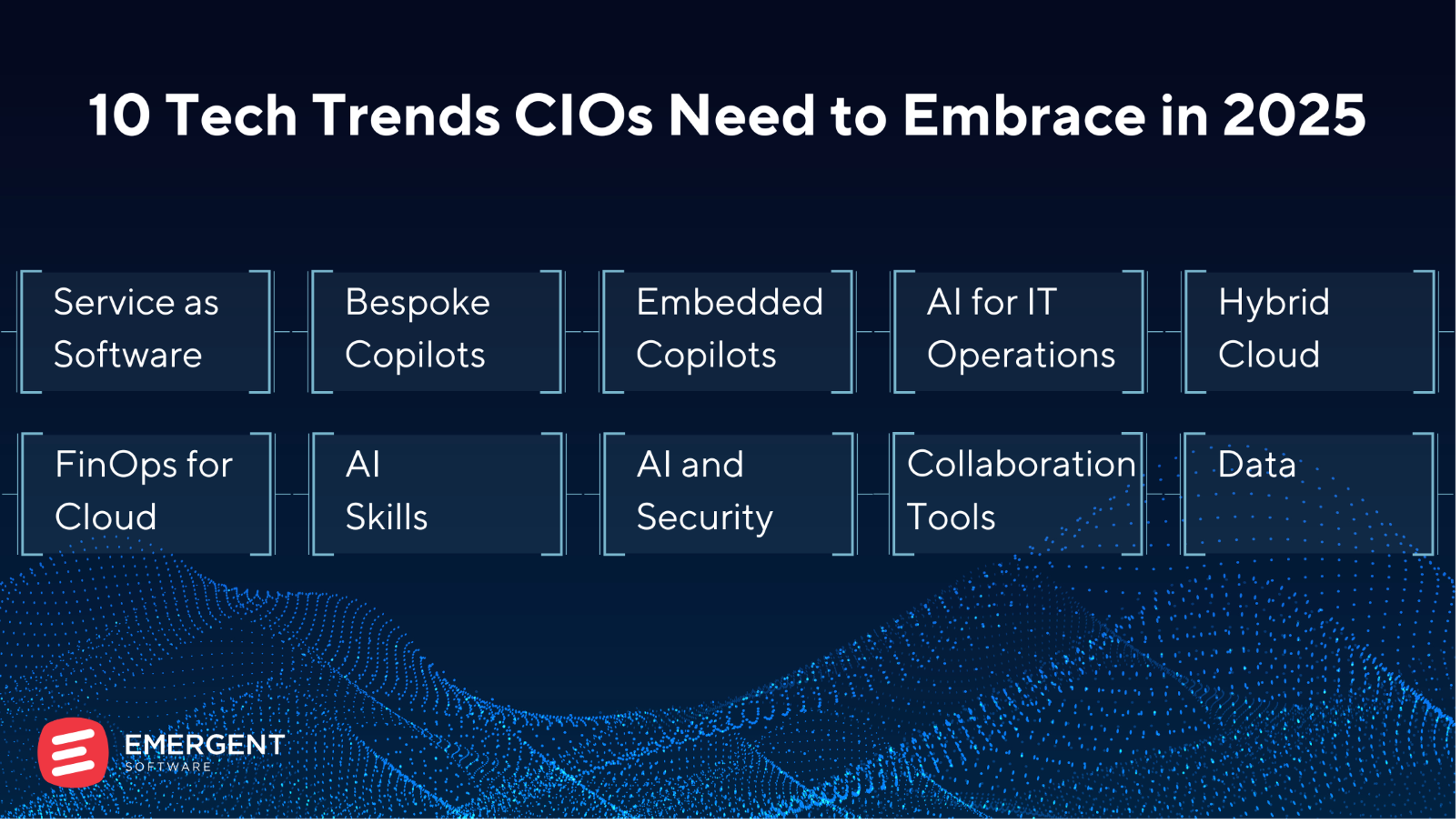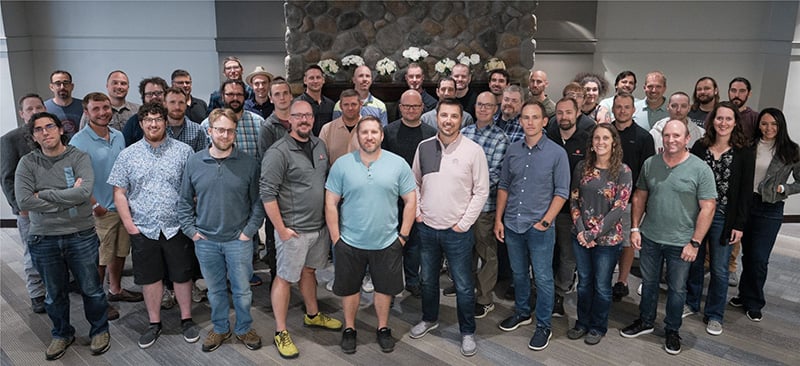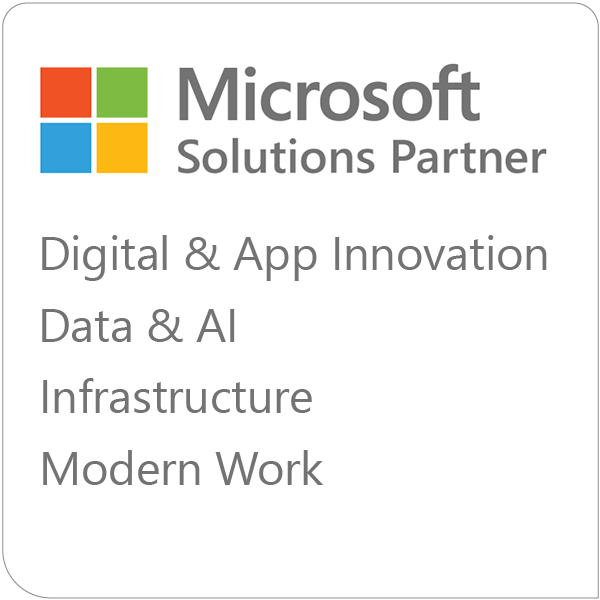
As we step into 2025, the pace of tech advancement continues to reshape the business landscape, challenging CIOs to remain agile and forward-thinking. From AI-driven automation and hybrid cloud strategies to personalized AI copilots and cutting-edge collaboration tools, the technology trends emerging this year are set to redefine how organizations operate and compete. In this blog, we’ll explore the top 10 technology trends every CIO needs to embrace to drive innovation, enhance efficiency, and stay ahead in an increasingly complex digital ecosystem.
1. Service as Software
Service as Software (SaaS) is revolutionizing the way businesses operate by offering scalable and flexible services that can be tailored to specific needs. This isn’t the software you are buying, but an automated service. Think about a virtual agent that can answer calls and direct your customers towards a resolution. It could be an accounts receivable agent answering questions from your suppliers. The business model may be a per transaction charge vs. a licensing cost. These service agents can augment staff or in some cases can prequalify inquiries before sending them to a service representative.
You may also like: What Is SaaS? Software as a Service Explained
2. Bespoke Copilots to drive productivity
Bespoke Copilots are customized AI assistants designed to enhance productivity by automating routine tasks and providing intelligent insights. These copilots can be tailored to specific business processes and workflows, helping employees focus on high-value activities. By leveraging machine learning and natural language processing, bespoke copilots can understand context, predict needs, and offer proactive suggestions, ultimately driving efficiency and innovation within organizations.
3. Embedded Copilots from your software providers
Embedded Copilots are AI assistants integrated directly into software applications by providers. These copilots offer contextual assistance, streamline workflows, and enhance user experience by providing real-time support and recommendations. Assuming you are a Microsoft customer, embrace their Copilots in Office 365. The productivity gains in Teams meeting alone is worth the investment. Almost every major software provider is embedding AI Copilots and can deliver immediate value within that eco-system. CIOs need to stay informed about these advancements to leverage the full potential of their software investments and improve overall productivity.
4. AI is changing IT Operations
AI is transforming IT operations by automating complex tasks, improving system performance, and enhancing security. AI-driven tools can monitor and analyze vast amounts of data in real-time, identify anomalies, and predict potential issues before they escalate. This proactive approach to IT management reduces downtime, optimizes resource utilization, and ensures a more resilient infrastructure. As an example, Microsoft’s Intune Copilot can accelerate triage of end-point issues employees may be experiencing. CIOs must embrace AI in IT operations to stay competitive and maintain operational excellence.
You may also like: Intro to AI: What is Artificial Intelligence and How Can Your Business Use It?
5. Hybrid Cloud is here to stay
Hybrid Cloud solutions combine the best of both public and private compute, offering cost efficiencies, flexibility, scalability, and security. This approach allows businesses to optimize their IT infrastructure by leveraging the strengths and cost efficiencies of on-premise data centers for fixed compute needs and cloud providers for scalable compute needs. Hybrid Cloud requires thoughtful data integration, supports diverse workloads, and provides a robust disaster recovery strategy. CIOs need to develop strategies to manage and optimize these environments effectively as the cost of public cloud is only increasing.
You may also like: The Benefits (and Limitations) of Hybrid Cloud Environments
6. FinOps has to lead your Cloud Strategy
FinOps, or Financial Operations, is crucial for managing cloud costs and ensuring financial accountability. As cloud adoption grows, so do the complexities of managing cloud expenditures. Different from on-premise where costs are fixed, cloud costs are variable and can quickly get away from you, if not managed appropriately. FinOps practices help organizations gain visibility into their cloud spending, optimize resource usage, and align cloud investments with business goals. CIOs must prioritize FinOps to drive cost efficiency and maximize the value of their cloud strategy.
7. Level-up your staff with AI skills
As AI becomes increasingly integrated into business operations, it is essential to equip staff with the necessary skills to leverage these technologies effectively. Training programs and upskilling initiatives focused on AI and machine learning can empower employees to innovate and drive business growth. CIOs should invest in AI education, experimentation and create a culture of continuous learning to stay ahead in the rapidly evolving technological landscape.
8. Security is getting harder, AI is why
While AI offers numerous benefits, it also introduces new security challenges. Cybercriminals are using AI to develop sophisticated attacks, making it harder to protect sensitive data and systems. CIOs must adopt advanced security measures, including AI-driven threat detection and response, to safeguard their organizations. Staying ahead of AI-powered threats requires continuous monitoring, robust security protocols, and a proactive approach to cybersecurity.
9. Collaboration Tools are getting better, empower your employees
Modern collaboration tools are transforming the way teams work together, enabling seamless communication and collaboration across different locations and time zones. Through Microsoft Office365, you can use Copilots to summarize attachments, meetings, take notes, schedule meetings, find places to meet, create rich documents with embedded code, links, and data bases, manage hybrid work environments, and manage tasks and due dates. Let alone offer features like real-time messaging, video conferencing, and document sharing. CIOs should leverage advanced collaboration tools to empower employees, improve teamwork, and drive business success.
10. Data is the gold in your business you need to unleash
Data is a valuable asset that can drive strategic decision-making and business growth. It is the foundation of what powers AI and your Copilot agents. By harnessing the power of data, organizations can uncover insights, identify trends, make informed decisions, create new products, and better serve their customers. CIOs must prioritize their data platform – ingestion, quality, normalization, expression, security, and governance - to enable analytics to unlock the full potential of their data, turning it into actionable intelligence that can propel the business forward.
Final Thoughts
The rapid evolution of technology presents both challenges and opportunities for CIOs in 2025. By adopting these ten trends—ranging from AI integration and FinOps strategies to enhanced collaboration tools and data-driven insights—you can position your organization for long-term success. Staying proactive, investing in upskilling, and fostering a culture of innovation will enable your teams to thrive in this transformative era. Embrace these shifts with confidence, and watch as your business evolves to meet the demands of tomorrow.
Frequently Asked Questions
1. What are the top technology trends CIOs should focus on in 2025?
CIOs should prioritize several key technology trends in 2025 to stay competitive and drive innovation:
- Service as Software (SaaS): Revolutionizing business operations with scalable, automated services tailored to specific needs, such as virtual agents and accounts receivable automation.
- Bespoke Copilots: Customized AI assistants designed to enhance productivity by automating tasks and providing intelligent insights.
- Embedded Copilots: AI assistants integrated into software applications, offering contextual assistance and streamlining workflows.
- AI in IT Operations: Leveraging AI for real-time data analysis, anomaly detection, and predictive issue resolution to optimize performance and security.
- Hybrid Cloud Solutions: Combining public and private cloud resources for flexibility, scalability, and cost efficiencies.
- FinOps (Financial Operations): Managing cloud expenditures effectively to align investments with business goals.
- AI Skills Development: Upskilling employees to leverage AI technologies for innovation and growth.
- Advanced Security Measures: Addressing AI-driven security threats with robust, proactive protocols and monitoring systems.
- Enhanced Collaboration Tools: Utilizing modern solutions like Office 365 Copilots to empower employees, improve teamwork, and manage hybrid work environments.
- Data Utilization: Prioritizing data platforms and analytics to unlock actionable insights, drive decision-making, and power AI applications.
2. How is AI expected to impact IT operations in 2025?
AI is set to revolutionize IT operations by automating complex tasks, improving system performance, and enhancing security measures. AI-driven tools can monitor and analyze vast amounts of data in real-time, identify anomalies, and predict potential issues before they escalate, leading to reduced downtime and optimized resource utilization.
3. What is the significance of FinOps in cloud strategy for 2025?
FinOps, or Financial Operations, is crucial for managing cloud costs and ensuring financial accountability. As cloud adoption grows, FinOps practices help organizations gain visibility into their cloud spending, optimize resource usage, and align cloud investments with business goals, driving cost efficiency and maximizing value.
4. Why is hybrid cloud a key trend for CIOs in 2025?
Hybrid cloud solutions offer a blend of public and private cloud resources, providing cost efficiencies, flexibility, scalability, and security. This approach allows businesses to optimize their IT infrastructure by leveraging the strengths of both environments, supporting diverse workloads, and ensuring robust disaster recovery strategies.
5. What challenges does AI pose to cybersecurity?
While AI offers numerous benefits, it also introduces new security challenges, as cybercriminals may use AI to develop sophisticated attacks. CIOs must adopt advanced security measures, including AI-driven threat detection and response systems, to safeguard their organizations. Staying ahead of AI-powered threats requires continuous monitoring, robust security protocols, and a proactive cybersecurity approach.








